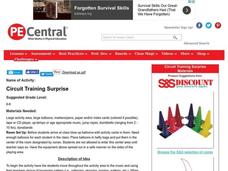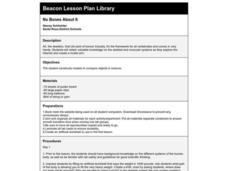Curated OER
America Moves to the City (1865-1900)
Statistical data can show shifts in human populations without bias or a prescribed historical point of view. View bar graphs and charts that describe new influxes in urbanization, immigration, and suffrage by state during the turn of the...
Science Geek
Electrons in Atoms
Electrons could never be Bohring! The presentation covers where you find electrons in an atom. It begins with the Bohr Model, then moves on to the Heisenberg Principle and orbital shapes. It concludes with the concept of electron spin...
Curated OER
Backpacking - Lesson 5 - Getting in Shape for the Trail
Do you have to be in decent condition to go on a weekend backpacking trip? This resource stresses the importance of fitness in backpacking. There are many ways to get the legs, the lungs, and the heart ready for a strenuous excursion....
Have Fun Teaching
Compound Word List
Never run out of compound words to teach your pupils by keeping this list nearby! All 16 pages are made up of lists of words organized alphabetically.
Curated OER
Muscles in Motion
Students identify the muscles and body motions of the human body. For this physiology lesson, students participate in different body motions to discover and explore the muscles that they use in their arms. Students discuss the names of...
Curated OER
Circuit Training Surprise
Students move around the gym to music, and when the music stops, they sit on a balloon. Inside each balloon are directions for another physical activity students should do.
Curated OER
No Bones About It
Students conduct Internet research on the different parts of the skeletal system. Then they create a model arm that demonstrates how muscle and bone work together to create movement.
Curated OER
THE PHYSICS OF MOVING THINGS (AND NOT A MOMENTUM TOO SOON!)
Learners list three examples of momentum found in their local environment; describe the importance of mass and velocity on momentum; and determine what is necessary to produce the greatest amount of momentum within a particular system.
Curated OER
Pump It Up
In this muscles worksheet, students read an article about building muscles and keeping them strong. Students choose any muscle in their body and use a website to learn about that muscle. They chart four muscles and exercises used to...
Curated OER
Electronic Structure of Atoms
In this chemistry instructional activity, students complete 22 problems and fill in the blank questions on quantum numbers, electron configuration and hybridization of orbitals.
Curated OER
Number Crunching
Students are shown 3-5 different types of crunches as well as the correct Fitnessgram curl-ups. They do sets of different types of crunches and count the total number by using multiplication skills. Studnets do multiple sets and count...
Curated OER
Electronic Structure of Atoms
In this atoms worksheet, students read information about the Schroedinger equation and the orientation of the orbitals. Students determine the electron configuration and energy level diagram for given elements. This worksheet has 22...
Curated OER
Muscles in Motion
Students explain how biceps and triceps work. In this life science lesson, students conduct an experiment to test which muscle (biceps or triceps) is stronger. They calculate class average from the result.
Curated OER
Breaking News English: Teacher on Trial for Attacking Student
For this English worksheet, students read "Teacher on Trial for Attacking Student," and then respond to 1 essay, 47 fill in the blank, 7 short answer, 20 matching, and 10 true or false questions about the selection.















